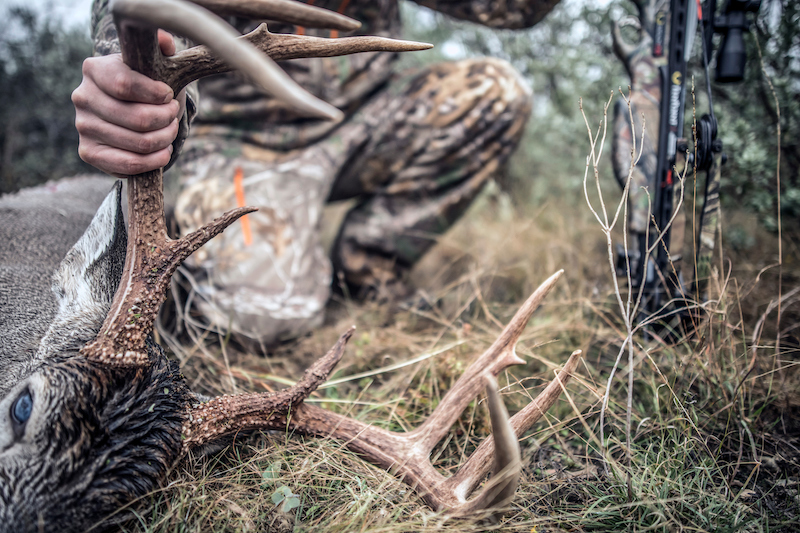“What’s hunting pressure?”
That’s like asking, “What’s a trophy buck?”
If you ask a dozen people, you’ll likely get 12 different responses. It’s all based on each hunter’s personal experiences and expectations. But hunting pressure isn’t just a concept. Deer react to increased human intrusions during hunting season.
From a human perspective, hunting pressure varies greatly. A bowhunter with a large private lease to himself during the week might think that handful of hunters who show up for the weekend send deer into a tizzy. But hunters who routinely find 10 pickups in the parking lot at a wildlife-management area on opening day of gun season likely have a different opinion.
Therefore, let’s agree hunting pressure is an increase in human activity in a deer’s domain. It has an impact — usually perceived as negative — on deer activity.
Hunters usually don’t like other hunters in the woods. They leave scent, jump deer from their bedding areas, and disrupt their routines. In fact, it’s not unusual for other hunters to unknowingly walk near your stand after you’ve painstakingly crept into the woods in the darkness while practicing careful scent control. Other hunters can pretty much ruin your hunt, but it’s a regular occurrence on public lands. Savvy hunters, however, anticipate how increased human activity affects deer movements, and use it to their advantage.

Designate a space where there is no human interaction. Photo Credit: John Hafner
It’s important to realize that deer often respond differently to hunting pressure. For instance, some hunters create sanctuaries on their properties. These are usually bedding areas that are off limits to humans, except when tracking wounded deer. One whiff of human odor in a sanctuary can alarm whitetails.
In contrast, bowhunters are often asked to thin burgeoning deer populations in urban areas. These hunts are often held in small woodlots within city limits. Deer are accustomed to human activity, and wanderthrough yards to browse on gardens and scavenge under birdfeeders. These deer tolerate more human activity, and some are barely fazed by a bowhunter’s human odor. In most scenarios, however, deer go on high alert when smelling or seeing humans where they seldom venture.
How do deer react to increased human activity? Incidental encounters here or there might not alter their patterns much, but deer that regularly contact humans usually limit their daytime activities. That makes them much harder to hunt. Still, deer rarely abandon their home range. They’re infinitely familiar with their turf and feel much safer there, even when humans intrude. Once deer realize they’re being hunted, you might have to wait for rut-crazed bucks to let hormones get the best of them. Once they make a mistake, you must be ready to capitalize on the opportunity.
Another option is to give the area a rest and let deer resume their normal activities. Hunting the same treestand or ground blind day after day usually nets diminishing returns, even in good locations. You’ll increase human scents and potential contacts with deer as you sneak to and from your stand. Hunting different sites on the property or letting it rest regularly can re-establish normal deer activity.
States with short, intense rifles seasons often report deer quickly returning to normal patterns once the orange army departs. You can get the same results on your hunting property, too.

Position yourself on the opposite end of the entrance. When hunters arrive, the deer will run away from the crowd and straight to you. Photo Credit: John Hafner
Another tactic is to use other hunters to your advantage. One of my friends, for example, arrived at a popular public-hunting area two hours before daylight one Saturday for a late-season hunt. No other vehicle was in the parking lot when he arrived. He then toted his climbing treestand to a pinch point where he hoped deer would travel to escape hunters entering the woods en masse at dawn.
The plan worked. A half-hour after daybreak, a doe crept toward him, watching its backtrail while moving toward heavy cover at the property’s center. As my friend dragged his hard-won deer back to the truck, he passed at least two other hunters still working their way into the woods. He counted 11 vehicles once he was back at the parking lot.
Hunting pressure, despite its negative meanings, is neither good nor bad. We’d all like to have the woods to ourselves. We all like to hunt unpressured deer, and relax without bumping into other hunters or seeing them interfere with our hunts.
Still, hunting pressure is a reality, no matter where we hunt. If you learn how it affects deer movements and adapt to their reactions, you’ll experience the difference between venison stew and tag soup.